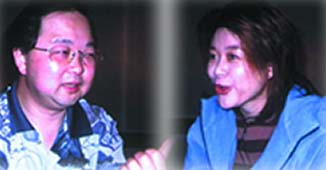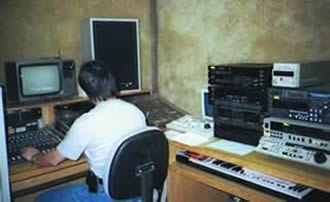
Dubbing
The voices behind cartoon characters
By Sandy Wong
Cartoon characters have not only cute
faces, but also funny voices.
These childish voices all come from adult
dubbing artists.
But dubbing is not an easy job.
“Being a dubbing artist is very challenging,”
said Miss Cheng Lai Lai, dubbing artist
for the Japanese cartoon character Chibi
Maruko Chan, known as Siu Yuan Chi in
Cantonese.
“It is very painstaking to do different
characters with different personalities every
day,” she said.
Miss Ng Siu Ngai, a dubbing artist for Asia
Television, added, “Due to the time
constraints and the teamwork nature of the
job, we sometimes need to wrap up our
work even if it is imperfect.
“Also, we need to stay in the studio for a
long time. In general, the pressure is quite
high.”
There also is pressure on dubbing artists to stay healthy.
“It makes me feel bad if I have a cold during a rush period,” said Miss Cheng. “If the audience listens to my voice carefully, they will notice that there is something wrong with it.
“Both the audience and I have to tolerate my unpleasant voice because it usually takes a long time for my voice to recover.”
To keep their voices healthy and pleasant, some dubbing artists avoid eating irritating foods.
Dubbing artists also speak in softer tones to keep their vocal cords from being strained.
“But the best thing is to have sufficient sleep,” said Mr. Lam Pou Chuen, a dubbing artist who has been working for Doraemon for 25 years.
Although it is not easy to be a dubbing artist, everyone in the profession seems to show a sense of satisfaction when talking about their favourite characters.
“I like the cartoon character Mr. Yamada in Nintama Rantarou, a Japanese ninja cartoon, very much.
“He is a very funny ninja instructer. Sometimes he acts like a nosy woman, while at other times he is a smart and considerate teacher of his students,” Mr. Lam said.
“I like Chibi the most because she is very popular in Hong Kong,” said Miss Cheng. “This cartoon helps me understand traditional Japanese culture.”
In addition to dubbing cartoon voices, Miss Cheng sometimes dubs the voices of characters in foreign progammes.
“I like Noriko Sakai very much. She is the eldest sister in the Noriko family of the popular Japanese series called Under the Same Roof.
“I feel very content when dubbing a voice for her because I think my voice matches her appearance and personality very well.
“Then people feel very comfortable when watching the series,” she said.
But dubbing the voice of a human being is often more difficult than dubbing for a cartoon character.
“Expressing the emotions of cartoon characters has fewer constraints because we can exaggerate their emotions,” said Mr. Lam.
He always observes his characters during rehearsals in order to think of special way to express the unique personalities.
“Although we usually just imitate the original tone of the characters, sometimes we also add our own special feelings to make the remarks more natural,” he continued.
Miss Ng also said it is more difficult to dub for human beings.
Said she: “The emotions of cartoon characters are more superficial and thus easier to imitate.
“But, comparatively, the emotions of human beings are usually inner, so we need more time to contemplate how to express them.”
At the same time, her enthusiasm and experience in the profession help her to get involved with various characters.
“Creativity is very important, too,” added she.
Paramount for every dubbing artist is catching the inner mood of a character, no matter if it is a cartoon character or a human being.
Mr. Lam takes ideas from his environment to improve his skills.
Said he: “For example, in each generation, there are new phrases and words.
“If I observe how different people usually speak, I can use more daily phrases in the cartoon to make it more familiar to the audience.”
In addition, he emphasized the need for mutual learning.
Said he: “Learning new things from colleagues, especially from newcomers, is one key to improvement.”
In the past, this job was more difficult due to poor sound recording equipment.
“Luckily, the equipment is more advanced now,” said Miss Ng. “And there is a trend to use the original voices of the characters in movies.
“Once a director told me that no audience likes dubbed voices nowadays.”
The dubbing profession no longer seems mysterious and significant in the eyes of audiences, especially since there are more people in Hong Kong who can understand both English and Japanese.
Said Miss Cheng: “Moreover, the standards of the audience have been raised and their demands on our profession have increased.
“It has become essential for us to upgrade our skills.”
However, this trend does not represent a slump in the dubbing industry.
Said Miss Ng: “Foreign cartoons and movies have been imported to Hong Kong continuously in the recent years from many different countries like South Korea and the Philippines.
“It is impossible for the audience to understand all of the different foreign languages.
“Moreover, Cantonese is definitely the most familiar to local people.”
Nevertheless, the work of dubbing artists is often underappreciated by the audience.
But as Mr. Lam said, “The job of a dubbing artist can never be neglected.
“It is like flavouring: The amount useded cannot be either too much or too little.”
